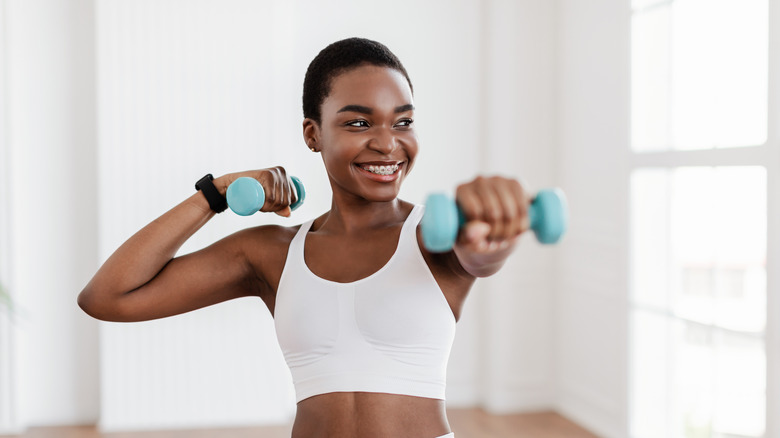How To Stay In Shape Using Only Light Weighs (And A Little Dedication)
When it comes to strength training, it always seems like it's go big or go home. If you were to browse through any fitness influencer's social media platform, you'd most likely find them benching 200 pounds or doing the leg press with even more. You'll also see them struggling even to move the weight but pushing through anyway as their muscles pop with a whole lot of definition. It's rare to see anyone lift a ten-pound or lower dumbbell.
As a beginner to strength training, these videos inspire you to get into the gym, but once you start moving weights, you realize it might take longer to get there than anticipated. But no worries, everybody starts somewhere, and the inspirational gym pros began with the lighter weights before making their way up too. As you start, you may feel as though you're not doing much as you lift lighter weights even if you're struggling.
This feeling can further be exacerbated by being surrounded by experienced gym-goers who barely take a look at the lighter weights. It can cause you to go far heavier than your body is able to handle and potentially injure yourself due to improper form. While there's no denying that, for women, lifting heavy weights can be beneficial to both mental and physical health, going lighter can also have numerous benefits that you shouldn't sleep on.
Lifting lighter helps you form a better mind-muscle connection
When you use lighter weights, you're more likely to actually work the muscle group you're targeting. If the weights you're using are too heavy, you might be swinging your limbs around to gain the momentum to move them the way you want them to go. Whereas, with a lighter weight, the muscle works to move the weight. A lighter weight can also help you to target smaller and harder-to-work muscles more effectively. If you were to use a heavier weight for these muscles, the stronger and bigger muscles would be forced to take over to complete the move.
Contrary to popular belief, gaining muscle mass is also possible with a lighter weight. As Robert Morton, a Ph.D. candidate in kinesiology and lead author of a study that explored the role of heavier weights in hypertrophy, explained to Muscle and Fitness: "If you want to get bigger, what drives muscle growth is how much effort, not load, you lift with."
He added "Using light weights until 'failure' will stimulate and grow both your type I and type II muscle fibers — the type II fibers being those which had always been associated with only heavy lifting." If you feel like lighter weights don't get you to the point of failure, you need to up the reps to the 12 to 15 range. Ideally, the last couple of reps in your set with any size weight should be hard to perform with proper form.
It helps you achieve more than just muscular definition
With a heavier weight, you might be limited to a certain range of motion, but when you go lighter, you have the freedom to freely move in a full range. If you're looking to gain endurance then lighter weights with more reps are great, because they keep your muscles working for longer. Lighter weights can also help you gain better balance and speed due to the increased range of motion.
This benefit of lifting light is known to serve runners in particular because they continuously subject their leg muscles to the strain of running, and with better endurance, they're able to accomplish their run with greater stamina and fewer chances of injury. Even if you're not an athlete, greater muscle endurance will reduce pain and fatigue as you go about your day completing your chores. You'll also have a safer workout because lifting light reduces your chances of injury.
Regardless of whether you're an experienced gym-goer or a beginner, there are always new moves to learn. To perform them effectively, without hurting yourself, you need to start light and work your way up gradually. The key to getting better results with lighter weights is to progressively overload. This doesn't necessarily mean you have to go heavier, but rather you need to put more effort into each set. More effort could mean resting less to reduce the time when the muscle isn't under tension or even controlling the tempo of the movement.


